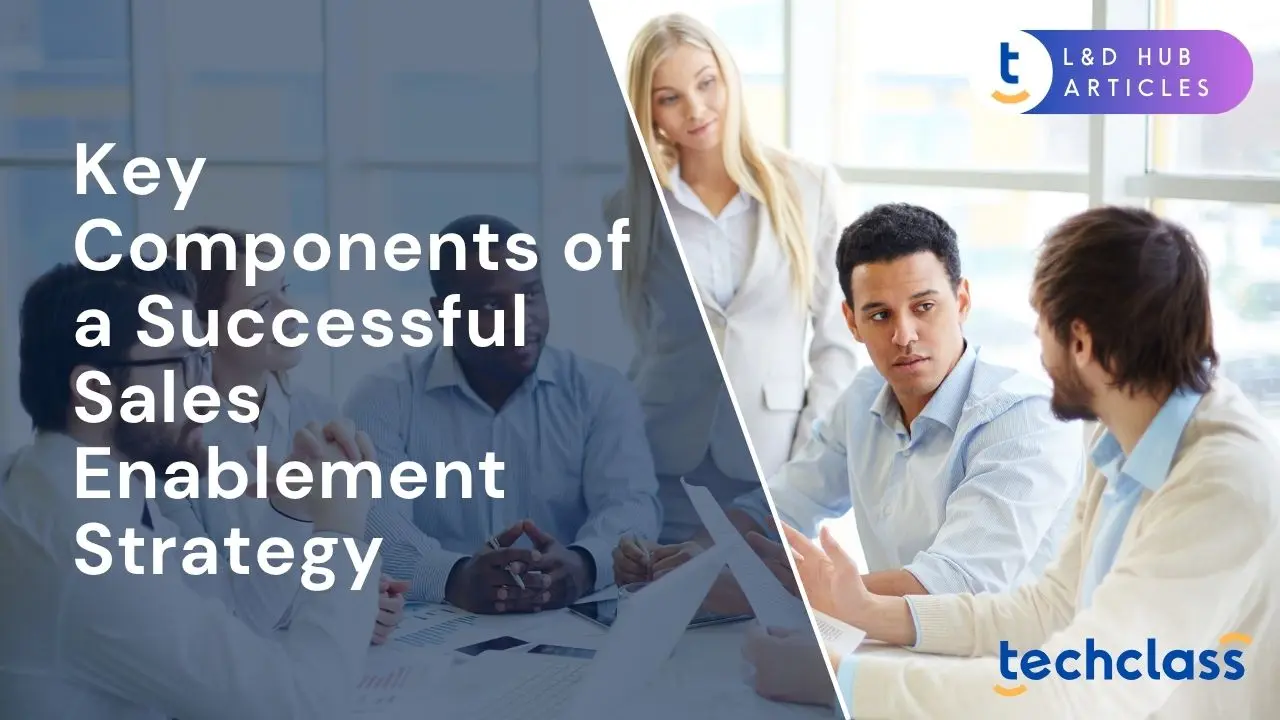
In today’s competitive marketplace, giving your sales team the right support can be the difference between missing targets and achieving record-breaking growth. Modern B2B buyers often do extensive research before engaging with a sales rep, so salespeople must provide real value when they finally connect with a prospect. A sales enablement strategy is the structured plan to equip your sales team with the training, content, tools, and processes they need to sell effectively. This approach has quickly become mainstream: by 2023, around 90% of organizations had a dedicated sales enablement program, and companies with a formal strategy enjoy significantly higher win rates on deals (nearly 50% better). Sales enablement doesn’t just boost revenue – it also accelerates new hire ramp-up and helps keep sales talent onboard by giving them the resources and support they need.
In this article, we break down the key components of a successful sales enablement strategy. Whether you’re an HR professional, a business owner, or an enterprise leader, these foundational elements will help you empower your sales team and achieve better results.
The first requirement for a successful sales enablement strategy is strong leadership support and alignment across departments. Executive buy-in is crucial – the C-suite should treat sales enablement as a strategic priority and assign clear ownership for its execution. In practice, that means designating a person or team (for example, a Sales Enablement Manager or enablement task force) to coordinate all the moving parts. Without a clearly accountable owner, enablement efforts can stall or fall through the cracks.
Effective sales enablement also acts as a bridge across departments, so cross-functional collaboration is vital. Sales, marketing, product, and HR (or Learning & Development) all need to work in concert to support the sales force. For example, marketing can provide on-brand collateral and share customer insights, product teams update sales on product changes, and HR helps coordinate training. When these stakeholders are aligned and communicating, the messaging to customers stays consistent and everyone works toward the common goal of improving sales performance. In short, leadership support sets the tone, and cross-functional alignment ensures that enablement isn’t happening in a silo but is embraced across the organization.
A successful sales enablement strategy requires a clear, well-defined sales process that aligns with how your buyers make decisions. This means mapping out each stage of the sales cycle – from initial contact and discovery, through proposal and closing, to post-sale follow-up – and ensuring these stages correspond to the buyer’s journey. A standardized sales process provides a roadmap for reps to follow, creating consistency and making it easier to train new salespeople since there’s a clear playbook of steps and best practices.
Equally important is keeping the process customer-centric. Today’s buyers expect salespeople to act as trusted advisors who understand their needs and challenges. To support this, define your ideal customer profiles and buyer personas as part of your strategy, and educate the sales team on these targets. By understanding who the buyer is – their industry, pain points, decision criteria, etc. – reps can tailor their approach and messaging. Also consider that complex B2B deals often involve multiple stakeholders. Your sales process should equip reps to navigate these multi-person buying committees by addressing the different priorities of each decision-maker (for example, a CFO’s concerns versus those of a technical lead).
Overall, a clear and buyer-aligned sales process improves efficiency, provides a consistent customer experience, and ultimately increases the likelihood of winning deals.
Even the best sales process needs to be supported by effective sales content and collateral. Sales content refers to the brochures, presentations, case studies, product datasheets, demos, email templates, and other materials that reps use to inform and persuade buyers. Providing high-quality, relevant content – and making it easily accessible – is a core element of sales enablement.
In many organizations, sales reps spend an inordinate amount of time searching for or recreating content. Studies have found that the average salesperson may spend only about one-third of their time actually selling, because so many hours are lost to tasks like hunting down information or building slide decks. To combat this, a successful enablement strategy includes a centralized content repository where all current sales assets are organized and readily available. This could be a digital library or portal that categorizes content by product, industry, sales stage, and so on. With such a system in place, a rep can quickly find the materials they need, rather than scrambling to piece together information.
Quality and relevance of content are just as important as accessibility. Sales and marketing should collaborate to develop collateral that speaks directly to customer needs and pain points. Each piece of content should serve a clear purpose in the sales cycle. Early-stage materials might educate the buyer about a problem or emerging trend (establishing why change is needed), whereas later-stage materials (like ROI calculators, detailed proposals, or customer success stories) should reinforce why your solution is the best choice. It’s also critical to keep content up-to-date and on-brand – outdated or inconsistent information can quickly erode a prospect’s trust. Part of content management involves regularly auditing the library and refreshing or retiring assets so that the sales team always has fresh, accurate resources.
By equipping your salespeople with the right content at the right time, you not only make their jobs easier but also deliver a more consistent and compelling message to buyers. Reps can respond faster to customer questions with factual, pre-approved information. Prospects, in turn, receive valuable insights and proof points that help them make informed decisions. An effective content strategy also prevents waste – it ensures the marketing efforts that go into creating collateral (like whitepapers, videos, or case studies) result in tools that sales will actually use. In sum, managing sales content and collateral effectively is a key component of enabling your team to engage prospects successfully and close more deals.
A cornerstone of sales enablement is comprehensive training and onboarding for your team. It’s not enough to hire great salespeople – you need to properly equip them with the knowledge and skills to excel in your organization’s context. A structured onboarding program for new sales hires is essential. This includes educating them about your products or services, target customers, the sales process they’ll follow, and the tools they’ll use (such as your CRM and other sales software). Onboarding may involve formal classes or e-learning, shadowing experienced reps, and milestone check-ins to ensure new hires are progressing. Investing in thorough onboarding pays off: salespeople who receive robust training become productive faster and feel more confident. Conversely, neglecting training can lead to frustration and high turnover. With a solid enablement program, companies often find that new reps can reach full productivity in significantly less time (sometimes cutting the ramp-up period by several months), which means faster ROI on hiring.
Training isn’t a one-time event. To maintain peak performance, continuous development and coaching should be woven into your sales enablement strategy. Even veteran salespeople need refreshers and new skills as markets, products, and sales techniques evolve. Regular coaching sessions are one effective way to achieve this. Sales managers or enablement coaches can work with reps individually – for example, reviewing sales call recordings or deals in progress to provide feedback and mentorship. Ongoing training workshops or webinars can reinforce best practices and introduce new tactics (for instance, a seminar on social selling or an update on a new product release). Incorporating role-play exercises keeps skills sharp and helps reps practice handling objections or delivering pitches in a low-pressure setting. Continuous coaching is also critical for reinforcement: without it, people tend to forget much of what they learned in initial training. By revisiting key concepts and introducing advanced techniques over time, you ensure that knowledge sticks.
This ongoing development steadily elevates the team’s performance and boosts morale. Reps who receive regular coaching often grow from average to top performers, and they’re more likely to stay with a company that invests in their success.
Modern sales enablement relies heavily on the right tools and technology to streamline processes and provide actionable insights. Building a productive sales tech stack should be a deliberate part of your strategy. At the core is a reliable Customer Relationship Management (CRM) system, which acts as the central hub for customer and pipeline information. A well-utilized CRM ensures that sales activities (calls, emails, meetings, pipeline updates) are tracked and that no opportunities fall through the cracks. Training your sales team to use the CRM effectively and maintaining data quality are important tasks, because accurate data in the CRM powers many other enablement efforts (like generating useful reports or triggering targeted follow-ups).
Beyond the CRM, consider deploying a sales enablement platform or content management system to organize and distribute collateral and sales playbooks. This platform houses the sales content we discussed earlier – making it easy for reps to find and share the latest materials – and may also include features like version control and usage analytics. Some enablement platforms even track content usage and effectiveness, helping you see which assets contribute most to closing deals.
Other tools to consider include sales engagement software (to automate and track communications), learning management systems (to deliver training content and track progress), and analytics dashboards (to monitor key metrics). Finally, ensure any new tool is actually adopted by the team – involve reps in its selection and training so it genuinely helps rather than hinders their work.
The final key component of a successful sales enablement strategy is establishing performance metrics and driving a cycle of continuous improvement. It’s essential to measure the impact of your enablement efforts so you can double down on what works and adjust what doesn’t. Start by defining the metrics that align with your sales objectives and the specific enablement initiatives you’ve implemented. For example, you might track win rates (percentage of deals won), quota attainment (the proportion of reps hitting their targets), average sales cycle length (how long it takes to close a deal), and ramp-up time for new hires. You could also monitor things like content usage (which sales assets are most frequently used and most effective) or training outcomes.
Suppose you see win rates jump after introducing a new sales playbook – that’s a clear sign the initiative is working. Conversely, if many deals consistently stall at a particular stage (for instance, in the proposal phase), it may indicate reps need additional support such as negotiation training or better pricing tools to push deals through. Metrics provide a factual feedback loop for your strategy.
However, quantitative data is only part of the story. It’s equally important to gather qualitative feedback from the field and incorporate it into your continuous improvement loop. Create channels for sales reps and managers to share their insights – for instance, through regular team meetings and debriefs. You might learn that reps feel they need more competitive information for certain pitches, or that a particular piece of content isn’t resonating with prospects. These insights are invaluable because they allow your enablement team to respond by updating training, creating new content, or tweaking the sales process.
For instance, if a new tool isn’t being used, you might offer more training on it or choose to replace it. If a particular training program yielded great results, you might expand it to more teams. The key is to treat your enablement strategy as a living program that evolves with your business.
In summary, by tracking performance and staying receptive to feedback, you ensure that your sales enablement strategy remains effective and relevant. This data-driven, iterative approach helps you continuously fine-tune the components – whether it’s improving a piece of content, enhancing a training module, or adjusting a sales play – to better support your sales team.
Building a successful sales enablement strategy is an ongoing journey that requires attention to people, processes, and tools. The components discussed – from leadership buy-in and aligned processes to rich content, solid training, continuous coaching, smart technology use, and data-driven refinement – all interconnect to create an environment where sales teams can thrive. When these elements are in place, your salespeople are more confident and capable, your departments collaborate more smoothly, and your customers receive a better, more consistent experience.
Remember that sales enablement is not a one-time project to check off a list – it’s a continuous commitment. Start by establishing these key components in a way that fits your organization’s unique needs, and then be ready to adapt. Solicit feedback, watch the metrics, and refine your approach as necessary. Over time, this consistent focus will cultivate a sales organization that is agile and empowered. That is the ultimate goal of a successful sales enablement strategy: to build a sales team that can continually excel and drive your business forward.
A sales enablement strategy is a structured plan to equip sales teams with training, content, tools, and processes to sell effectively. It boosts revenue, accelerates onboarding, and improves sales performance.
Cross-functional alignment ensures collaboration between departments like sales, marketing, product, and HR, providing consistent messaging, supportive resources, and a unified approach to sales success.
A customer-centric sales process aligns with the buyer's journey, addressing their needs and decision criteria, making sales efforts more efficient and increasing deal closure rates.
Sales content supports reps with relevant materials such as case studies, presentations, and scripts, helping respond to customer needs faster and delivering a consistent message.
Tools like CRMs, content management platforms, and sales engagement software streamline processes, improve data accuracy, and provide insights for continuous improvement.
Continuous training and coaching help reps stay updated on market changes, refine skills, and prevent skill stagnation, leading to higher performance and retention.


